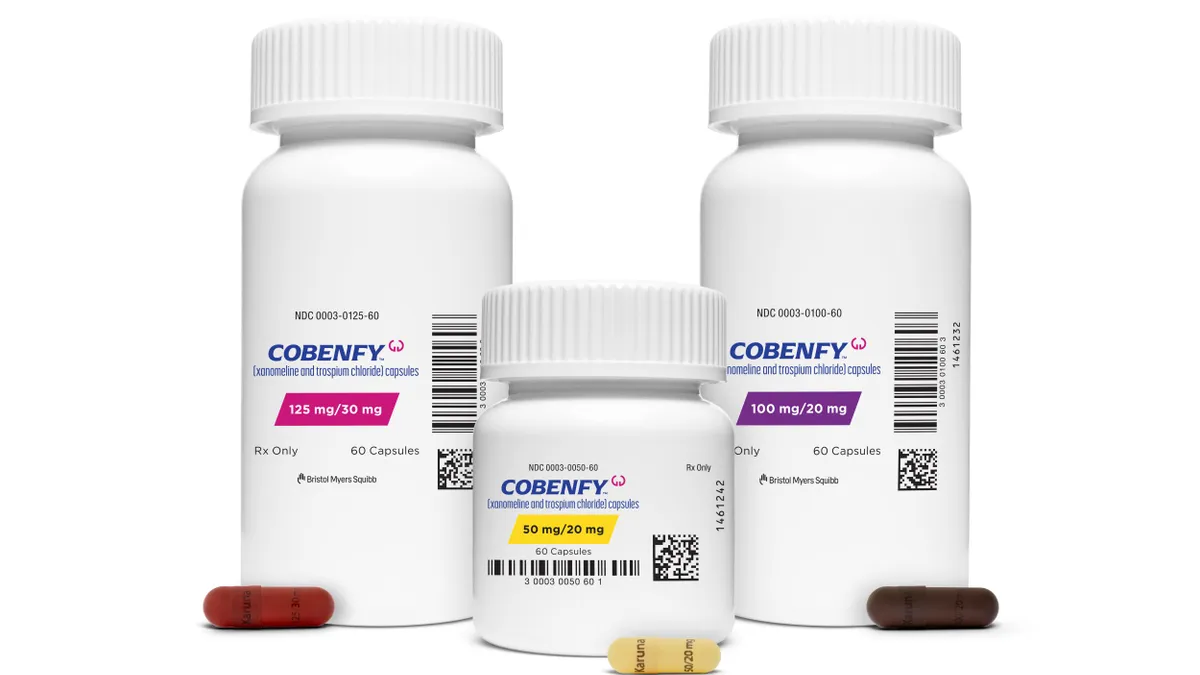 The Food and Drug Administration for several years has been advocating for the use of computer modeling and simulation as a way to accelerate access to new therapies. First proposed by the agency in 2011 as part of its Critical Path Initiative, modeling and simulation are gaining traction, with the global biosimulation market expected to reach $3.77 billion by 2024, according to Grand View Research.
The Food and Drug Administration for several years has been advocating for the use of computer modeling and simulation as a way to accelerate access to new therapies. First proposed by the agency in 2011 as part of its Critical Path Initiative, modeling and simulation are gaining traction, with the global biosimulation market expected to reach $3.77 billion by 2024, according to Grand View Research.
The need to make drug development more efficient and informative is a clear driver of market growth, and industry leaders expect increasing use of the technology in all phases of development, from discovery to Phase IV. Several major pharmaceutical companies are committed to developing their modeling capabilities as part of their R&D strategies.
Computer simulation is the process of building a mathematical model that mimics a real-world situation. Over the last 15 years, with advancements in computer science, the world has embraced an alternative paradigm called the “algorithm modeling" culture, says Lucas Glass, global head, analytics center of excellence, IQVIA.
“The shift away from the classical statistical world of data modeling and toward the computer science world of algorithm modeling has driven the increased use of computer simulation," he says. “The computer science world’s connection to practical software development has enabled companies to focus more on business goals than statistical purity."
In parallel, evolving technologies in health research, including new computational chemistry approaches and the application of big data, began to be applied to pharmaceutical research and development.
“Pharmaceutical modeling and simulation are already providing transformative potential 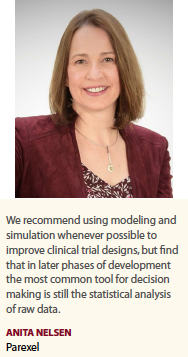 for patients, as well as impacting the potential to reduce time and cost to reach investigational new drug milestones," says Kenneth Koblan, Ph.D., head of global translational medicine and early development and head of discovery sciences, Sunovion Pharmaceuticals.
for patients, as well as impacting the potential to reduce time and cost to reach investigational new drug milestones," says Kenneth Koblan, Ph.D., head of global translational medicine and early development and head of discovery sciences, Sunovion Pharmaceuticals.
“Being able to seek accessible endpoints will help us obtain answers quicker to simpler questions in the clinical development process," he says. “From my perspective, we are operating in an age where engineering is meeting medicine — all enabled with data."
Dr. Koblan says to lower risks and reduce delays in getting new treatments to patients, Sunovion continues to put an emphasis on cutting-edge translational approaches, such as new modeling and simulation techniques, functional neuroimaging, and other methods for demonstrating desired CNS activity and target engagement. “This helps to enable more rapid and effective decision-making in Phase I and Phase II trials," he says.
“These innovative approaches have significant clinical potential, as well as the ability to harness new regulatory pathways."
Other companies are using this type of technology as well. For example, Roche’s clinical pharmacology team, which is part of the pharma research and early development (pRED) unit, is predicting the outcomes of clinical trials by simulating different clinical trials designs. AstraZeneca, Bristol-Myers Squibb, GlaxoSmithKline, and Pfizer are participating in a U.K. initiative, called Advanced Digital Design of Pharmaceutical Therapeutics (ADDoPT), that aims to streamline drug development and manufacturing by leveraging better computer-based process modeling and simulation.
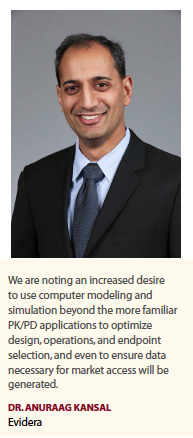 Industry leaders say modeling and simulation have become essential to modern drug development, impacting key decisions in all phases of the process: increasing the understanding of benefit/risk, determining go/no go decisions, and assessing safety and efficacy of new therapies.
Industry leaders say modeling and simulation have become essential to modern drug development, impacting key decisions in all phases of the process: increasing the understanding of benefit/risk, determining go/no go decisions, and assessing safety and efficacy of new therapies.
“No new airplane takes to the sky or new car rolls off the assembly line without having every nut and bolt simulated beforehand in the computer," says Thomas Kerbusch, Ph.D., president of Certara Strategic Consulting. “Yes, human biology, disease, and drug treatment are more complex engineering problems than designing an airliner, but that shouldn’t stop us from using virtual engineering of drug development to improve its efficiency. We owe that to the patients in need of better therapies."
Despite being highly recommended by regulatory authorities, modeling and simulation technologies are still used in a limited way. Simulation, also called in silico modeling, is most frequently used for pharmacokinetic and pharmacodynamic modeling, which aims to look at drug absorption, distribution, metabolism, and excretion.
Modeling is also used to evaluate Phase I data to decide dosing for Phase II, to support Phase III dose selection, QTc modeling to address drug-related cardiac QT prolongation, PK/PD modeling to identify subpopulations that might require different dosing regimen, and to address regulatory questions/concerns.
“We recommend using modeling and simulation whenever possible to improve clinical trial designs but find that in later phases of development the most common tool for decision making is still the statistical analysis of raw data," says Anita Nelsen, senior director and head, genomic medicine and quantitative clinical development services, Parexel.
Dr. Kerbusch says what the drug development world needs is a willingness to embrace modern technologies that have had deep impact on other industries for years. “A paradigm shift from the empirical medical-only trained led pharma organizations to one where computer science and known pharmacological and biological concepts are merged, all data available are integrated, and knowledge moves into a model-based framework, from wet-bench scientists to virtual R&D," he says.
Factors Driving Modeling and Simulation
Industry leaders say the traditional approach of three discrete, fixed trial phases 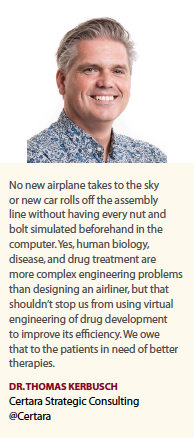 designed for testing mass-market drugs often is not viable in today’s increasingly competitive, value-based therapeutic markets. The current approach lacks the flexibility, analytic power, and speed required to develop complex new therapies targeting smaller patient populations.
designed for testing mass-market drugs often is not viable in today’s increasingly competitive, value-based therapeutic markets. The current approach lacks the flexibility, analytic power, and speed required to develop complex new therapies targeting smaller patient populations.
Computer simulation offers a cost and time-efficient way to improve trial design, operations and outcomes, and these efficiencies have been consistent drivers of adoption.
Total sponsor cost per new drug approved in the United States jumped 145% in just 15 years to more than $2.5 billion in 2014, according to the Tufts Center for Drug Development. At the same time, just 7% of first-in-human drugs gained FDA approval.
The explosive increase in computing power now available makes it possible to provide a crystal ball for drug developers, enabling researchers to predict the outcomes from given scenarios, predict future study results, and enable better study design planning.
In silico modeling combines the advantages of both in vivo (in living organisms) and in vitro (in a test tube) experimentation, without the subjection to the ethical considerations and lack of control associated with in vivo experiments.
Unlike in vitro experiments, in silico models allow the researcher to include a virtually unlimited array of parameters, which render the results more applicable to the organism as a whole.
“Such a model has predictive potential and can be used to explore the therapeutic window of the compound, the efficacy/toxicity in specific populations, and alternative administration routes or formulations all before actually conducting the clinical study," Ms. Nelsen says. “This leads to a considerable saving in time and costs: predictions can help in establishing whether it is appropriate to invest time and money on the specific compound, or whether to divert resources to other more promising compounds.
Furthermore, there is also an ethical aspect to be considered, which see patients treated in clinical studies with dose regimens based on a higher degree of certainty compared with no model-based administration protocols."
Computer simulation of clinical trials forces our understanding and hypotheses about a trial to be described explicitly and quantitatively, says Anuraag Kansal, Ph.D., senior research leader and director, modeling and simulation, Evidera.
“Computer simulation enables better informed evaluation of these hypotheses," he says. “A related benefit is improved communications across different stakeholders in the trial  by providing a common framework for discussion of their priorities. It is much more cost-efficient and less risky to analyze and assess a design via a simulation than after making major investments to conduct a clinical trial. Also, simulation can be used to examine aspects that might be tricky or too risky to consider in an actual trial."
by providing a common framework for discussion of their priorities. It is much more cost-efficient and less risky to analyze and assess a design via a simulation than after making major investments to conduct a clinical trial. Also, simulation can be used to examine aspects that might be tricky or too risky to consider in an actual trial."
Evidera has created disease models that can be used for simulation of clinical trials.
These have been implemented in multiple contexts and recently allowed the company to correctly predict the results of an ongoing trial and address regulatory concerns with imbalances in a favorable, post-hoc analysis.
“We are seeing increasing enthusiasm from trialists about the role of computer simulation and modeling," Dr. Kansal says. “In particular, we are noting an increased desire to use these techniques beyond some of the more familiar PK/PD applications to optimize design, operations, and endpoint selection, and even to ensure data necessary for market access will be generated."
Mr. Glass says computer simulations can increase the ROI per dollar spent on R&D.
“With more accurate predictions of how a drug will perform in a population, sponsors can more efficiently direct their clinical trial portfolios," he says. “Sponsors can more finely tune their studies to increase the likelihood of successful trials, and can make more informed decisions as to which physicians and countries to engage for their clinical research."
Mr. Glass heads a team called the Analytics Center of Excellence (ACOE) with more than 100 modern data scientists who work with clinicians and clinical operations experts.
“We have seen substantial improvement in the operational efficiency and predictability of our studies," he says. “Based on the early successes of the ACOE, we are investing resources to further embed data science within the clinical trial world. We see great promise with in silico clinical trials where we can model the outcome of patient-level drug response. We have driven toward increased use of synthetic control arms."
Dr. Kerbusch says a typical example is model-based meta-analysis where virtual head-to-head trials between the new drug candidate and standard of care or competitors are done.
“Modeling informs on the likelihood and certainty of beating standard of care or a competitor," he says. “A virtual trial can be run at a fraction of the cost of the actual trial, 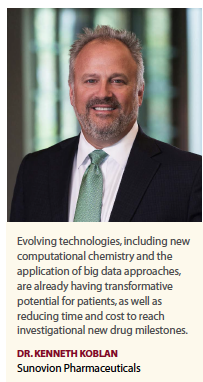 meaning a full range of sensitivity checks can be conducted on underlying assumptions of the drug’s performance, impact of the study population on the outcome, and impact background therapy and residual trial variability before the trigger is pulled on the actual trial."
meaning a full range of sensitivity checks can be conducted on underlying assumptions of the drug’s performance, impact of the study population on the outcome, and impact background therapy and residual trial variability before the trigger is pulled on the actual trial."
Dr. Kerbusch says optimizing trial design and pressure-testing helps avoid the all too prevalent trial outcome failures, such as lack of differentiation from standard-of-care or competitors, unexpected risk/benefit deterioration due to patient population or background therapy.
Industry leaders say the adoption of simulation for clinical trials is being further driven by regulatory interest in synthetic arms that can address questions regarding comparators not included in Phase III trials. All of this is enabled by the advancing capabilities of simulation and biopharmaceutical companies expanding portfolios of relevant data.
Leadership at the FDA has a strong vision of the role of modeling and simulation in drug development and regulatory approval. The current FDA Commissioner Scott Gottlieb announced, as part of the agency’s Innovation Initiative, support for in silico tools in clinical trials for improving drug development and making regulation more efficient.
Mr. Gottlieb posted a blog early in his tenure in 2017: “FDA’s Center for Drug Evaluation and Research (CDER) is currently using modeling and simulation to predict clinical outcomes, inform clinical trial designs, support evidence of effectiveness, optimize dosing, predict product safety, and evaluate potential adverse event mechanisms. We’ll be putting out additional, updated guidance on how aspects of these in silico tools can be advanced and incorporated into different aspects of drug development."
“Regulators may request or require modeling to support definition of dose selection, differentiation from placebo or address other safety or efficacy related queries," Ms. Nelsen says. “Further, developers are turning to model-based drug development to help mitigate risk of attrition, reduce costs and duration of drug development, improve efficiency, optimize protocol designs, and support interpretation of results. Model-based approaches have been demonstrated to have a positive impact on the development and registration of medicinal products."
Challenges of Implementing Modeling
Mr. Glass says over the past year, a few themes have arisen around challenges in the computer-modeling world. First, the quality of the data must be paramount.
“In the real-world setting, data are not collected with controls often associated with clinical trial data," he says. “Therefore, substantial effort must be invested into ensuring the high quality of real-world patient data. Second, there must be a greater collaboration between the computer science world and the clinical world. We often see clinical modeling articles published in the computer science domain without any clinical input.
Like the classical biostatistics world where clinical experts and statistical experts were well integrated, the modern data science world must also integrate."
Ms. Nelsen says interpretation of the data can also a challenge.
“The value of the model is indirectly related to the number of assumptions made to build it," she says. “Model-based decisions in all phases of development have to take into account what assumptions are, what the numerical results mean in practice, and what these results entail for future clinical practice. The key message should be that modeling is not only a set of technicalities, but it is a way to organize and quantify the available knowledge and at the same time to produce new physiological/pharmacological knowledge."
Additionally, Mr. Kansal says as increasing amounts of data and computational power are used in trial simulation, a key challenge will be ensuring the results of simulations are used in a way that is consistent with their design and inputs.
“Simulation findings must continue to be interpreted with the benefit of clinical and operational expertise," he says. “Opportunities for validating the simulations remain scarce, but validation is extremely important to foster trust in the results. Creating sophisticated, valid simulators is a labor-intensive task that cannot be reasonably done separately for each trial. Thus, sponsors must be willing to support and use general simulators that competitors also can use."
Ms. Nelsen says one of the biggest challenges is related to the availability of a skilled and experienced workforce.
“Skilled pharmacometricians with a good understanding of clinical pharmacology and mechanism of action of the drug are in high demand as model-based drug development becomes more common," she says.
Dr. Kerbusch says large pharma companies routinely incorporate modeling and simulation into their drug development programs, and stay current by actively participating in educational workshops, consortia, and peer-review journals.
“Smaller biopharma companies struggle with staying abreast of these learnings," he says. “In fact, many are emerging companies with virtual R&D teams with no understanding of modeling and simulation and its rising impact on drug development."(PV)





